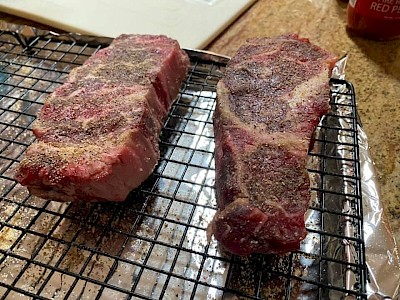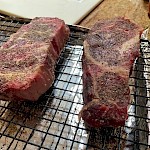
If you’ve ever roasted a turkey, you’ll probably be familiar with brining. If you’re not, the nutshell is this: brining is a technique wherein you soak meat in a salt water solution for some period of time, anywhere from a few hours to several days if it’s a particularly large cut or a full-sized bird. The idea is that you are simultaneously tenderizing your meat while the seasonings basically soak in, seasoning much deeper inside your cut than a simple dusting of salt and pepper. Brining provides a depth of flavor and tenderness that only seasoning right before cooking doesn’t match.
Dry brining is exactly what it sounds like; you use salt (and whatever other seasonings you like) to tenderize and boost the flavor of your meat, minus the water part. No leaky bags or sloshy Tupperware containers needed! And as long as you don’t go overboard with the salt, there’s no need for rinsing afterward, either.
Dry brining can be used to tenderize and season pretty much any cut of non-ground meat (dry brined baby backs were amazing, y’all). All you need is a baking tray that will fit in your fridge, a rack upon which your meat can stand, some coarse salt, your meat of choice, and whatever other seasonings you want to use. I rarely measure my seasonings when I dry brine my steaks, for example, but half pound piece of meat should get somewhere between 3/4 tsp and 1/2 tbsp of salt (read more about how it works and get some more concrete seasoning conversions and ideas here).
You can dry brine smaller cuts of meat for a minimum of an hour, or up to two days total. Larger cuts will probably need to stand overnight at a minimum. When you’re ready to cook, let your meat stand on the counter so it comes to room temperature and go to town grilling, smoking, baking, or pan frying to your favorite internal temperature. Once it’s done, you will have an incredibly tender and flavorful meal with very little extra effort. I call that a win!


